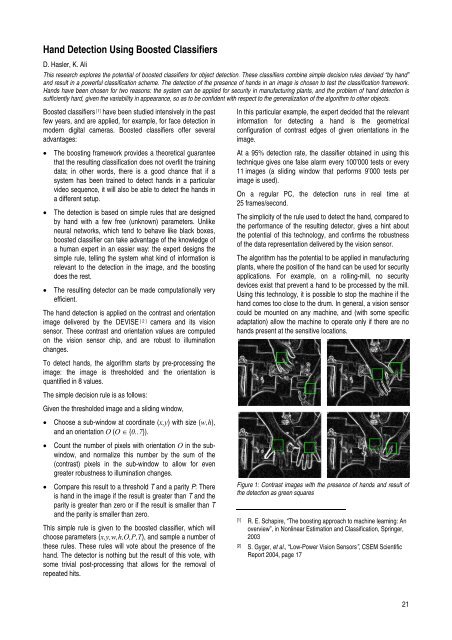CSEM Scientific and Technical Report 2008
CSEM Scientific and Technical Report 2008
CSEM Scientific and Technical Report 2008
Create successful ePaper yourself
Turn your PDF publications into a flip-book with our unique Google optimized e-Paper software.
H<strong>and</strong> Detection Using Boosted Classifiers<br />
D. Hasler, K. Ali<br />
This research explores the potential of boosted classifiers for object detection. These classifiers combine simple decision rules devised “by h<strong>and</strong>”<br />
<strong>and</strong> result in a powerful classification scheme. The detection of the presence of h<strong>and</strong>s in an image is chosen to test the classification framework.<br />
H<strong>and</strong>s have been chosen for two reasons: the system can be applied for security in manufacturing plants, <strong>and</strong> the problem of h<strong>and</strong> detection is<br />
sufficiently hard, given the variability in appearance, so as to be confident with respect to the generalization of the algorithm to other objects.<br />
Boosted classifiers [1] have been studied intensively in the past<br />
few years, <strong>and</strong> are applied, for example, for face detection in<br />
modern digital cameras. Boosted classifiers offer several<br />
advantages:<br />
• The boosting framework provides a theoretical guarantee<br />
that the resulting classification does not overfit the training<br />
data; in other words, there is a good chance that if a<br />
system has been trained to detect h<strong>and</strong>s in a particular<br />
video sequence, it will also be able to detect the h<strong>and</strong>s in<br />
a different setup.<br />
• The detection is based on simple rules that are designed<br />
by h<strong>and</strong> with a few free (unknown) parameters. Unlike<br />
neural networks, which tend to behave like black boxes,<br />
boosted classifier can take advantage of the knowledge of<br />
a human expert in an easier way: the expert designs the<br />
simple rule, telling the system what kind of information is<br />
relevant to the detection in the image, <strong>and</strong> the boosting<br />
does the rest.<br />
• The resulting detector can be made computationally very<br />
efficient.<br />
The h<strong>and</strong> detection is applied on the contrast <strong>and</strong> orientation<br />
image delivered by the DEVISE [ 2] camera <strong>and</strong> its vision<br />
sensor. These contrast <strong>and</strong> orientation values are computed<br />
on the vision sensor chip, <strong>and</strong> are robust to illumination<br />
changes.<br />
To detect h<strong>and</strong>s, the algorithm starts by pre-processing the<br />
image: the image is thresholded <strong>and</strong> the orientation is<br />
quantified in 8 values.<br />
The simple decision rule is as follows:<br />
Given the thresholded image <strong>and</strong> a sliding window,<br />
• Choose a sub-window at coordinate (x,y) with size (w,h),<br />
<strong>and</strong> an orientation O (O ∈ {0..7}).<br />
• Count the number of pixels with orientation O in the subwindow,<br />
<strong>and</strong> normalize this number by the sum of the<br />
(contrast) pixels in the sub-window to allow for even<br />
greater robustness to illumination changes.<br />
• Compare this result to a threshold T <strong>and</strong> a parity P: There<br />
is h<strong>and</strong> in the image if the result is greater than T <strong>and</strong> the<br />
parity is greater than zero or if the result is smaller than T<br />
<strong>and</strong> the parity is smaller than zero.<br />
This simple rule is given to the boosted classifier, which will<br />
choose parameters (x,y,w,h,O,P,T), <strong>and</strong> sample a number of<br />
these rules. These rules will vote about the presence of the<br />
h<strong>and</strong>. The detector is nothing but the result of this vote, with<br />
some trivial post-processing that allows for the removal of<br />
repeated hits.<br />
In this particular example, the expert decided that the relevant<br />
information for detecting a h<strong>and</strong> is the geometrical<br />
configuration of contrast edges of given orientations in the<br />
image.<br />
At a 95% detection rate, the classifier obtained in using this<br />
technique gives one false alarm every 100’000 tests or every<br />
11 images (a sliding window that performs 9’000 tests per<br />
image is used).<br />
On a regular PC, the detection runs in real time at<br />
25 frames/second.<br />
The simplicity of the rule used to detect the h<strong>and</strong>, compared to<br />
the performance of the resulting detector, gives a hint about<br />
the potential of this technology, <strong>and</strong> confirms the robustness<br />
of the data representation delivered by the vision sensor.<br />
The algorithm has the potential to be applied in manufacturing<br />
plants, where the position of the h<strong>and</strong> can be used for security<br />
applications. For example, on a rolling-mill, no security<br />
devices exist that prevent a h<strong>and</strong> to be processed by the mill.<br />
Using this technology, it is possible to stop the machine if the<br />
h<strong>and</strong> comes too close to the drum. In general, a vision sensor<br />
could be mounted on any machine, <strong>and</strong> (with some specific<br />
adaptation) allow the machine to operate only if there are no<br />
h<strong>and</strong>s present at the sensitive locations.<br />
Figure 1: Contrast images with the presence of h<strong>and</strong>s <strong>and</strong> result of<br />
the detection as green squares<br />
[1] R. E. Schapire, “The boosting approach to machine learning: An<br />
overview”, in Nonlinear Estimation <strong>and</strong> Classification, Springer,<br />
2003<br />
[2] S. Gyger, et al., “Low-Power Vision Sensors”, <strong>CSEM</strong> <strong>Scientific</strong><br />
<strong>Report</strong> 2004, page 17<br />
21








